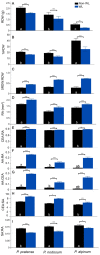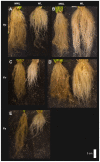Response to Waterlogging Stress in Wild and Domesticated Accessions of Timothy (Phleum pratense) and Its Relatives P. alpinum and P. nodosum
- PMID: 38068669
- PMCID: PMC10708118
- DOI: 10.3390/plants12234033
Response to Waterlogging Stress in Wild and Domesticated Accessions of Timothy (Phleum pratense) and Its Relatives P. alpinum and P. nodosum
Abstract
Timothy (Phleum pratense) is a cool-season perennial forage grass widely grown for silage and hay production in northern regions. Climate change scenarios predict an increase in extreme weather events with fluctuating periods of high rainfall, requiring new varieties adapted to waterlogging (WL). Wild accessions could serve as germplasm for breeding, and we evaluated the responses of 11 wild and 8 domesticated accessions of timothy, P. nodosum and P. alpinum from different locations in northern Europe. Young plants at tillering stage were exposed to WL for 21 days in a greenhouse, and responses in growth allocation and root anatomy were studied. All accessions produced adventitious roots and changed allocation of growth between shoot and root as a response to WL, but the magnitude of these responses varied among species and among accessions. P. pratense responded less in these traits in response to WL than the other two species. The ability to form aerenchyma in the root cortex in response to WL was found for all species and also varied among species and among accessions, with the highest induction in P. pratense. Interestingly, some accessions were able to maintain and even increase root growth, producing more leaves and tillers, while others showed a reduction in the root system. Shoot dry weight (SDW) was not significantly affected by WL, but some accessions showed different and significant responses in the rate of production of leaves and tillers. Overall correlations between SDW and aerenchyma and between SDW and adventitious root formation were found. This study identified two wild timothy accessions and one wild P. nodosum accession based on shoot and root system growth, aerenchyma formation and having a root anatomy considered to be favorable for WL tolerance. These accessions are interesting genetic resources and candidates for development of climate-resilient timothy varieties.
Keywords: accessions; aerenchyma; anatomy; forage grass; perennial; root.
Conflict of interest statement
The authors declare no conflict of interest.
Figures







References
-
- Jing Q., Bélanger G., Qian B., Baron V. Timothy Yield and Nutritive Value under Climate Change in Canada. Agron. J. 2013;105:1683–1694. doi: 10.2134/agronj2013.0195. - DOI
-
- Becker T., Isselstein J., Jürschik R., Benke M., Kayser M. Performance of Modern Varieties of Festuca arundinacea and Phleum pratense as an Alternative to Lolium perenne in Intensively Managed Sown Grasslands. Agron. J. 2020;10:540. doi: 10.3390/agronomy10040540. - DOI
-
- Radkowski A., Bocianowski J., Nowosad K., Piwowarczyk E., Bakinowska E., Radkowska I., Wolski K. Comparison of the Yield and Chemical Composition of Eleven Timothy (Phleum pratense L.) Genotypes under Three Locations in Poland. Agronomy. 2020;10:1743. doi: 10.3390/agronomy10111743. - DOI
-
- Preliminär Statistik, rapport JO0104. Swedish Board of Agriculture; Landskrona, Sweden: 2023. Jordbruksmarkens Användning 2023.
LinkOut - more resources
Full Text Sources

